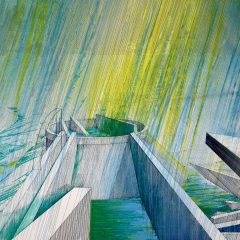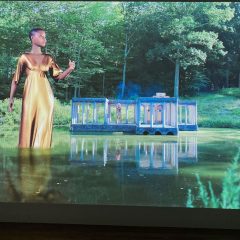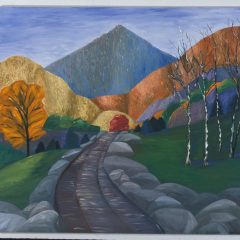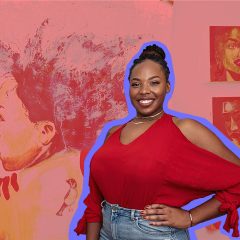Four laboratory mice escaped Emily Cobb’s imagination, exited the lab with a rope held aloft by blue balloons, and turned into a neckpiece. The rope wraps around the wearer’s neck, and the balloons sit like a stand-up collar. Emily begins the mice’s story: Four mice unaccounted for. One wire cage destroyed. Several ripped lab gloves found on table. Window ajar. Visitors to her exhibition, Legends, are encouraged to complete the tale. She provides blank books for that purpose, one for each piece of her exquisite, miniature sculptural jewelry, on display at the Philadelphia Art Alliance through Dec. 10, 2012. Visitors can also add their stories on her tumblr site, using one of the monitors provided.
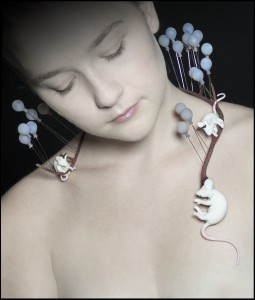
Another mouse jumped under a lily pad, and turned into a ring. When worn, the mouse appears in the palm of the hand, while his tail loops over a finger and around the lily pad, which sits above the fingers. These fairy tales come to life, unfolding around necks, fingers and ears, are cast primarily in colored nylon and photopolymers, from molds generated by three-dimensional, computer-ailed design (CAD). CAD is widely used by architects and engineers, as well as in medicine, the film industry and in video gaming. For Cobb, it is just another tool, even if it is an amazing one. The true distinction of her jewelry is her fluid and quirky imagination and her sensitivity to how her tiny, narrative figures interact with human anatomy.
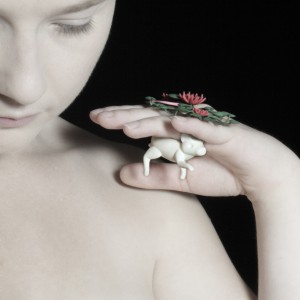
While her jewelry begins with fables and invented folk tales, their embodiment is highly attuned to the relationship of the neck and collarbones, the way a crown-like head-piece sits on the wearer’s shoulders and surrounds her head, and the manner in which a large ring affects the movement of the hand. The extraordinary neckpiece, The Bowed Horse: Untied, appears to be a ribbon tied into a soft bow around the neck, as an air-borne horse gallops behind the wearer’s head, the horse’s head and front legs appearing on her left, unravel into ribbon, as do the hind-quarters, visible to her right. It has the dynamism associated with the many horses, beloved of Baroque sculptors, that leap from fountains in cities across Europe, from Rome to Moscow (and across the U.S. well).

I suspect Cobb enjoys netskuke, the carved toggles which Japanese men slipped under their belts to hold pouches or boxes they used in lieu of pockets. They, too, are tiny sculptures, often narrative in nature, and designed to be comfortable in the palm of the hand. Cobb is part of perhaps the second or third generation of trained jewelers who have consciously rejected the notion of jewelry as a form of dowery or conspicuous wealth. Instead they work with everyday materials, from paper, plastic and rubber to wood, steel wire and found objects. Some also reject the decorative traditions of jewelry, creating un-conventional work that disrupts or restricts, rather than adorns the wearer’s body and clothing. This form of art jewelry is more visible in Europe than in the U.S.. I remember cases of jewelry in the Stedelijk Museum, Amsterdam, alongside painting, sculpture, and other work from the permanent collection. Cobb received her MFA from Tyler School of Art, which has one of the best jewelry departments in the country.
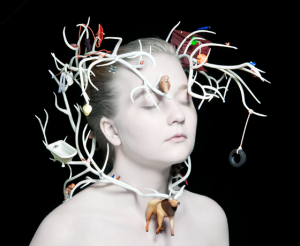
My personal favorite is Ursula’s Envy: The Diagnosis, a small, pink octopus that curls so it can sit at the entrance to the auditory canal, framed by the earlobe. I happen to like octopuses, but I also find it delightful that a piece of jewelry was designed to be worn in a place normally associated only with medical devices. The octopus’ story begins The X-rays surprise the doctor but confirm Ursula’s own suspicion: her inner ear is also half octopus. A four-year-old visitor named Lucy had her own story that began Once upon a goat in a faraway land there lived a baby, baby baby snail with a big, big brother … Lucy managed to insert a wolf into the story. But all ended well: They explained the wolf is dead and they ate him for supper. The End.




